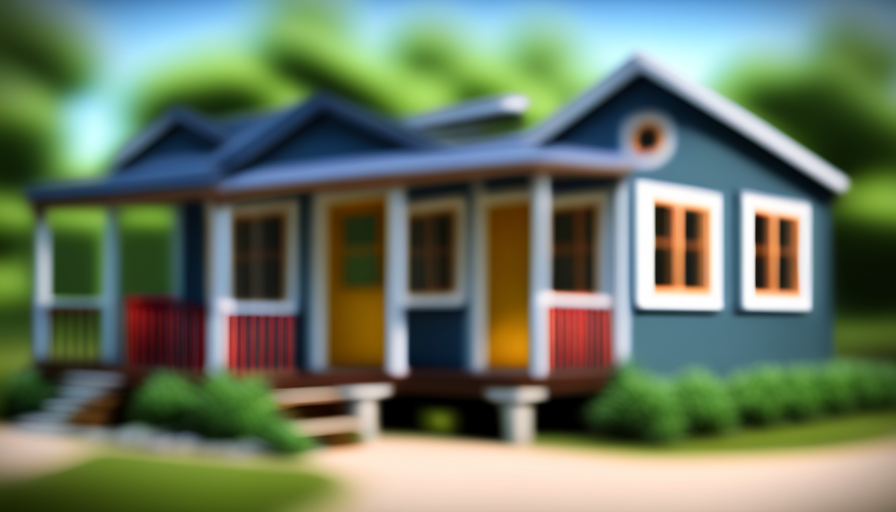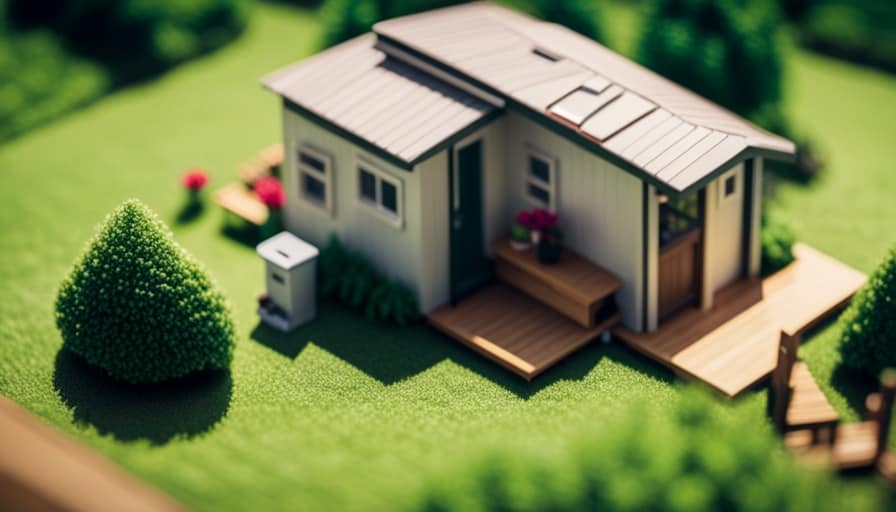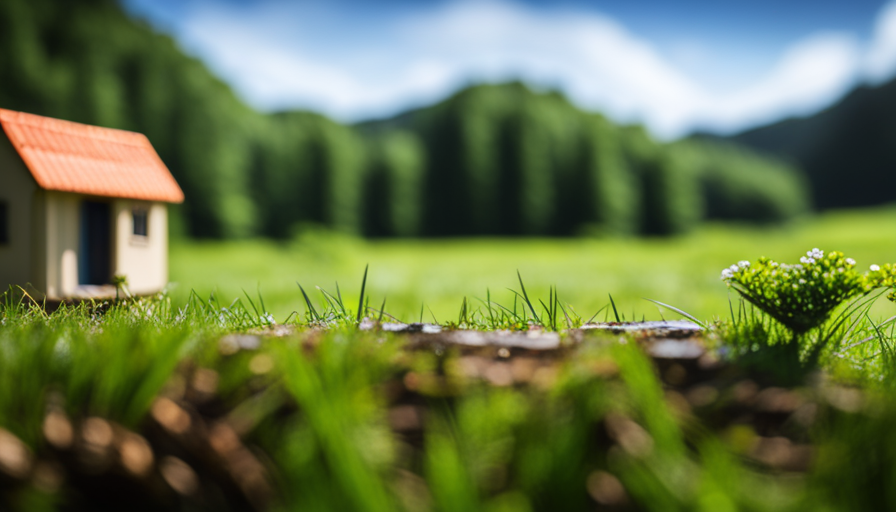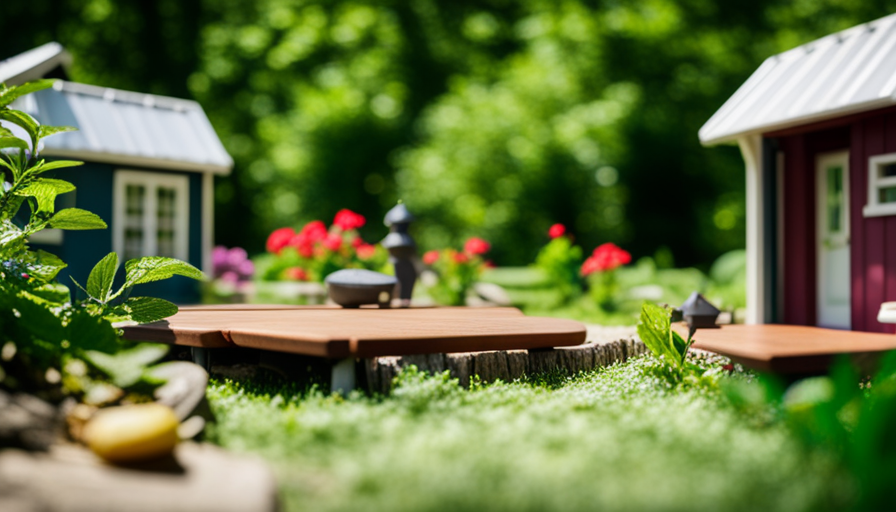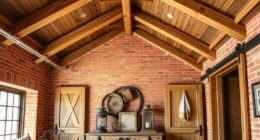In the realm of housing, bigger doesn’t always mean better. Sometimes, the most innovative ideas can be found in smaller packages. Imagine a situation where your residence embodies minimalism and efficiency, with every inch purposefully crafted to maximize functionality and minimize waste. Welcome to the world of tiny houses.
In this article, we delve into the fascinating world of 400 square feet tiny houses, exploring the question that lingers in the minds of many: how much do they actually cost? By analyzing construction materials and techniques, location considerations, size and layout, utilities and off-grid living, interior furnishings and appliances, financing and budgeting, maintenance and upkeep, insurance and legal considerations, as well as tips for cost-saving and budget-friendly choices, we aim to shed light on the true expenses of these petite dwellings.
So, if you’re curious about the financial implications of downsizing your living space and embracing a minimalist lifestyle, join me on this journey of discovery as we unravel the enigma of the 400 square feet tiny house cost.
Key Takeaways
- Construction materials and techniques greatly impact the cost of a 400 square feet tiny house, with stick-built construction being more expensive than prefabricated construction.
- The location of the tiny house plays a significant role in its cost, with urban areas generally being more expensive than rural areas due to land costs and availability.
- Off-grid living in a tiny house can be achieved through the use of solar panels for electricity, composting toilets to minimize water usage, and rainwater harvesting systems or water storage tanks as water sources.
- Space-saving furniture and storage solutions are important in maximizing the functionality of a tiny house, with popular options including Murphy beds, foldable dining tables, wall-mounted shelves, underbed storage drawers, and over-the-door organizers.
Construction Materials and Techniques
If you’re considering building a 400 sq ft tiny house, you’ll be amazed at the variety of construction materials and techniques available to create your dream home.
From traditional stick-built construction to innovative prefabricated options, the choices are endless. Construction techniques can greatly impact the overall cost of your tiny house. Stick-built construction, where the house is built on-site using traditional materials, tends to be more expensive due to labor costs. On the other hand, prefabricated construction, where the house is built off-site and assembled on location, can be more cost-effective. This method reduces labor costs and allows for quicker construction times.
When it comes to cost breakdown, the materials used play a significant role. Opting for high-end finishes and appliances can drive up the cost, while choosing more budget-friendly options can help keep expenses in check. Additionally, factors like insulation, roofing materials, and windows can also impact the overall cost. It’s important to research and compare prices to make informed decisions that align with your budget.
Transitioning into the subsequent section about location considerations, it’s essential to factor in the cost of land, permits, and utilities when determining the total cost of your tiny house.
Location Considerations
When considering the location for a tiny house, two key factors to keep in mind are land costs and availability, as well as zoning and building regulations.
Land costs can vary greatly depending on the area, with urban locations typically being more expensive than rural ones. Availability of suitable land can also be a challenge, as finding a plot that meets one’s needs and is within budget can be difficult.
Zoning and building regulations are important to consider, as they dictate what can be built and where. These regulations can vary from city to city and can impact the design and construction of a tiny house.
Land Costs and Availability
To understand the land costs and availability for a 400 sq ft tiny house, you’ll need to research local zoning regulations and explore theories that suggest limited land options for these small dwellings. Land availability and costs vary greatly depending on the location. In rural areas, land may be more abundant and affordable, while in urban areas, finding suitable land can be a challenge. According to a study conducted by the American Tiny House Association, the average cost of land for a tiny house is around $10,000 to $50,000. However, this price can fluctuate significantly based on factors such as location, amenities, and proximity to urban centers. It’s important to consider these factors and conduct thorough research before purchasing land for a tiny house. Understanding zoning and building regulations will further guide your decision-making process.
Zoning and Building Regulations
Navigating through zoning and building regulations can be a daunting task, but understanding these rules is crucial in order to successfully build your dream tiny home.
Zoning restrictions play a significant role in determining where you can place your tiny house. Some areas may have specific zoning regulations that prohibit tiny homes altogether, while others may have limitations on the size or location of the house.
Additionally, building codes dictate the minimum requirements for construction, ensuring safety and structural integrity. These codes cover various aspects such as electrical systems, plumbing, and insulation.
It’s essential to familiarize yourself with the specific regulations in your area to avoid any legal issues or setbacks during the construction process.
Understanding zoning and building regulations will help you make informed decisions when it comes to the size and layout of your tiny house, ensuring compliance with local laws and regulations.
Size and Layout
The cozy layout of a 400 sq ft tiny house creates a warm and inviting atmosphere. Despite its small size, careful planning and design can maximize the use of space.
When considering the size and layout of a tiny house, it’s important to take into account local building permits and regulations. Some areas may have specific requirements for minimum square footage or zoning restrictions that limit the placement of tiny houses. However, there are also communities specifically designed for tiny houses, where these regulations may be more lenient. These tiny house communities often provide a supportive environment for like-minded individuals who value minimalist living.
Additionally, the layout of a 400 sq ft tiny house can vary depending on individual needs and preferences. Some common features include open-concept living areas, loft spaces for sleeping, and efficient storage solutions. With careful consideration and planning, a 400 sq ft tiny house can provide all the necessary amenities and create a comfortable living space.
Transitioning into the subsequent section about utilities and off-grid living, it’s important to consider the practical aspects of living in a tiny house.
Utilities and Off-Grid Living
Living in a 400 sq ft tiny house allows you to embrace off-grid living and learn about the practical aspects of utilities in a cozy and sustainable way.
When it comes to off-grid power, solar panels are a popular choice for tiny house owners. They provide a reliable and renewable source of electricity, allowing you to power your lights, appliances, and electronics without relying on the grid.
Additionally, installing a composting toilet can help minimize water usage and reduce waste, making it a sustainable option for off-grid living.
As for water sources, there are a few options to consider. Rainwater harvesting systems can collect and store rainwater for various uses, such as drinking, cooking, and bathing. Alternatively, you can also explore drilling a well or using water storage tanks to ensure a steady supply of water.
Living off-grid in a tiny house allows you to take control of your utilities and live in a self-sufficient manner.
Transitioning into the subsequent section about interior furnishings and appliances, you can create a comfortable and functional living space within the limited square footage.
Interior Furnishings and Appliances
When it comes to interior furnishings and appliances for a tiny house, two key points to consider are space-saving furniture and storage solutions, as well as energy-efficient appliances and fixtures.
Space-saving furniture and storage solutions are crucial in maximizing the limited space available in a tiny house, allowing for multi-functional use of furniture and creative storage options.
Additionally, energy-efficient appliances and fixtures are essential to minimize energy consumption and reduce utility costs, which is especially important when living off-grid.
By carefully selecting these elements, one can create a functional and sustainable living space in a tiny house.
Space-Saving Furniture and Storage Solutions
Imagine how much space you could save with clever furniture and storage solutions in your 400 sq ft tiny house! When it comes to maximizing the limited space, investing in space-saving furniture and implementing organization hacks can make a world of difference. By choosing furniture that serves multiple purposes and incorporates storage compartments, you can optimize every square inch of your tiny house. Additionally, utilizing vertical space with shelves, hooks, and hanging organizers can help keep your belongings organized and easily accessible. To give you an idea of the possibilities, here is a table showcasing some popular space-saving furniture and storage solutions:
| Furniture/Storage Solution | Function | Benefits |
|---|---|---|
| Murphy Bed | Bed and storage cabinet in one | Saves floor space during the day |
| Foldable Dining Table | Dining table and workspace | Easily tucks away when not in use |
| Wall-Mounted Shelves | Storage and display space | Utilizes vertical space effectively |
| Underbed Storage Drawers | Additional storage | Maximizes space in the bedroom |
| Over-the-Door Organizer | Storage for small items | Keeps essentials within reach |
By incorporating these solutions, you can create a functional and organized living space in your tiny house. With the furniture and storage taken care of, let’s move on to discussing energy-efficient appliances and fixtures.
Energy-Efficient Appliances and Fixtures
Utilizing energy-efficient appliances and fixtures is crucial for optimizing the functionality and sustainability of your compact living space. In a 400 sq ft tiny house, every square inch counts, and choosing the right appliances and fixtures can make a significant difference in energy consumption and utility bills.
Energy-efficient lighting, such as LED bulbs, can reduce electricity usage by up to 80% compared to traditional incandescent bulbs. Additionally, using sustainable building materials, like reclaimed wood and recycled countertops, not only reduces environmental impact but also promotes a healthier indoor living environment. These materials often have lower VOC emissions, which can improve air quality.
By incorporating energy-efficient appliances and sustainable building materials, you can create a more eco-friendly and cost-effective living space.
Transitioning into the next section about ‘labor and professional services,’ it is important to consider the expertise required for building and maintaining a tiny house.
Labor and Professional Services
When it comes to labor and professional services in building a tiny house, there are two main options to consider: hiring contractors and builders or taking the DIY route. Hiring professionals can provide expertise and ensure that the construction meets all necessary codes and regulations.
On the other hand, opting for a DIY approach can save money but requires a significant amount of time, skill, and knowledge in various construction trades. Ultimately, the decision between DIY and professional construction depends on individual capabilities, budget, and desired level of involvement in the building process.
Hiring Contractors and Builders
Hiring contractors and builders can significantly impact the overall cost of a 400 sq ft tiny house. When considering the cost of hiring professionals for your tiny house project, there are several factors to keep in mind:
- Hiring architects: Collaborating with an architect can ensure that your tiny house is designed efficiently and meets your specific needs. They can help optimize the use of space and ensure the house is structurally sound.
- Managing construction costs: Contractors and builders play a crucial role in managing construction costs. They can provide accurate cost estimates, help you select cost-effective materials, and manage the project timeline to avoid unexpected expenses.
- Quality of workmanship: Hiring experienced contractors and builders ensures that the construction of your tiny house meets the highest standards. Their expertise can lead to a well-built and durable structure that will last for years to come.
Considering these factors, hiring professionals can be a wise investment in your tiny house project, ensuring a successful and cost-effective construction.
This leads us to the next topic: DIY vs. professional construction.
DIY vs. Professional Construction
Opting for either DIY or professional construction can greatly impact the overall outcome of your cozy abode. When it comes to cost comparison, it’s essential to consider the pros and cons of each approach. DIY construction allows for flexibility and personalization, but it requires a significant amount of time, effort, and DIY skills. On the other hand, professional construction ensures expertise and efficiency but can be more expensive. To help you make an informed decision, here’s a comparison of DIY and professional construction costs for a 400 sq ft tiny house:
| DIY Construction | Professional Construction | |
|---|---|---|
| Labor Cost | Time and personal effort | Professional fees and wages |
| Material Cost | Generally lower as you can shop around for deals | Typically higher due to contractor markups and quality materials |
| Timeframe | Longer due to learning curves and potential setbacks | Shorter due to professional experience and dedicated teams |
Considering these factors, it’s crucial to weigh the cost and benefits before proceeding with your preferred construction method. Moving on to financing and budgeting, it’s important to plan accordingly to ensure a smooth journey towards your dream tiny house.
Financing and Budgeting
To stay within your budget, you can consider financing options for a 400 sq ft tiny house. There are several ways to finance your tiny house, including obtaining a home loan or exploring other financial planning options. Here are five financing options to consider:
- Personal Savings: Using your personal savings to fund your tiny house is a straightforward option, as it allows you to avoid interest payments or loan fees.
- RV Loan: Some people opt for RV loans, as tiny houses on wheels can be classified as recreational vehicles. This option often offers competitive interest rates and longer loan terms.
- Personal Loan: Another option is to take out a personal loan from a bank or credit union. This can provide you with the flexibility to use the funds as needed for your tiny house project.
- Peer-to-Peer Lending: Peer-to-peer lending platforms connect borrowers and lenders directly. This option can sometimes offer more favorable terms and lower interest rates.
- Crowdfunding: If you have a compelling story or unique concept, you may consider crowdfunding your tiny house project. This involves seeking financial support from a community of individuals who believe in your vision.
By exploring these financing options, you can find the best fit for your needs and budget. Planning your finances well is crucial when embarking on a tiny house project.
Moving on to the next section about ‘maintenance and upkeep’, it’s important to consider the long-term costs of owning a 400 sq ft tiny house.
Maintenance and Upkeep
In the previous section, we discussed financing and budgeting for a 400 sq ft tiny house. Now, let’s shift our focus to the important topic of maintenance and upkeep. As with any home, regular maintenance is crucial to ensure the longevity and functionality of your tiny house.
When it comes to maintenance, there are two main aspects to consider: handyman services and long-term maintenance. While some people may have the necessary skills and time to handle basic repairs and upkeep themselves, others may prefer to hire professional handyman services. These services can help with tasks such as plumbing, electrical work, and general repairs.
Additionally, long-term maintenance is essential to prevent any major issues from arising. This includes regular inspections of the roof, foundation, and plumbing systems, as well as maintaining the exterior and interior of the house. By staying on top of these tasks, you can avoid costly repairs down the line.
To provide a visual representation of the maintenance and upkeep process, I have created a table below:
| Maintenance Tasks | Frequency |
|---|---|
| Roof Inspections | Annually |
| Plumbing Check-ups | Bi-annually |
| Exterior Painting | Every 3-5 years |
| Interior Maintenance | As needed |
Now that we have covered the importance of maintenance and upkeep, let’s move on to the next section about insurance and legal considerations.
Insurance and Legal Considerations
When it comes to insurance for your tiny home, did you know that nearly 60% of tiny house owners have found it challenging to find appropriate coverage? Insuring a tiny house can be a complex process due to its unique nature and the fact that it falls outside traditional homeowners or renters insurance policies. It’s crucial to find insurance coverage that not only protects your investment but also meets legal requirements.
Here are some important considerations when it comes to insurance and legal requirements for your tiny house:
- Specialized insurance: Due to the specific needs of tiny houses, it’s important to seek out insurance providers that specialize in tiny homes. These providers understand the unique risks associated with tiny houses and can offer tailored coverage options.
- Liability coverage: Adequate liability coverage is essential to protect yourself in case of accidents or injuries that occur on your property.
- Legal requirements: Depending on your location, there may be legal requirements for insurance coverage. Make sure to research and comply with any local regulations.
Finding the right insurance coverage and understanding the legal requirements for your tiny house can be challenging, but it’s crucial for protecting your investment and ensuring peace of mind. In the next section, we’ll explore tips for cost-saving and budget-friendly choices when it comes to your tiny house.
Tips for Cost-Saving and Budget-Friendly Choices
When it comes to cost-saving and budget-friendly choices for building a tiny house, there are two key points to consider. The first is the use of secondhand and repurposed materials. By utilizing reclaimed wood or salvaged fixtures, one can significantly reduce the cost of building materials. The second point is engaging in DIY and upcycling projects. This allows for the customization of the tiny house while keeping the budget in check. Overall, these strategies can help minimize costs and create a unique and affordable tiny house.
Secondhand and Repurposed Materials
You’ll be amazed at the potential and cost-saving benefits of using secondhand and repurposed materials for your 400 sq ft tiny house. Repurposed decor and secondhand appliances can not only add character to your space but also significantly reduce your overall costs. By opting for secondhand furniture and fixtures, you can save a substantial amount of money while still creating a unique and personalized living environment.
Additionally, repurposing materials such as reclaimed wood or salvaged doors can give your tiny house a rustic and eco-friendly touch.
- Consider visiting thrift stores, flea markets, and online marketplaces for affordable secondhand items.
- Look for materials that can be repurposed, such as old pallets or vintage windows, to add charm and character to your tiny house.
- Don’t be afraid to get creative and think outside the box when repurposing materials – the possibilities are endless!
- Remember to thoroughly clean and refurbish any secondhand items before incorporating them into your tiny house.
With the potential cost savings and unique aesthetic that secondhand and repurposed materials offer, you’ll be well on your way to creating a beautiful and budget-friendly 400 sq ft tiny house.
In the next section, we’ll explore exciting DIY and upcycling projects that can further enhance your tiny house.
DIY and Upcycling Projects
In my quest to explore affordable options for building a 400 sq ft tiny house, I stumbled upon a fascinating aspect: DIY and upcycling projects. This approach allows individuals to not only save money but also unleash their creativity by repurposing materials and upcycling furniture.
By embracing this trend, one can transform discarded items into functional and aesthetically pleasing additions to their tiny house. Not only does it contribute towards sustainability and reducing waste, but it also adds a unique touch to the overall design.
Upcycling materials such as reclaimed wood, old windows, and vintage fixtures can give the tiny house a charming and rustic appeal. Additionally, repurposing furniture can save a significant amount of money, as secondhand pieces can be found at affordable prices or even obtained for free.
Frequently Asked Questions
Are there any specific building codes or zoning regulations that need to be followed when constructing a 400 sq ft tiny house?
While constructing a 400 sq ft tiny house, it is crucial to adhere to specific building codes and zoning regulations. These regulations ensure safety measures, proper land use, and compliance with local laws.
Can a 400 sq ft tiny house be built on wheels for mobility purposes?
Yes, a 400 sq ft tiny house can be built on wheels for mobility purposes. However, it is important to ensure that it complies with building codes and zoning regulations for mobile structures.
What are the common challenges faced when finding a suitable location to park or place a 400 sq ft tiny house?
Finding a suitable location for a 400 sq ft tiny house presents challenges such as zoning restrictions, limited availability of land, and issues with utilities. These factors can impact the feasibility and cost of finding an appropriate place to park or place the tiny house.
Are there any restrictions on the size or placement of utilities, such as water and sewage connections, for a 400 sq ft tiny house?
Restrictions on water and sewage connections for a 400 sq ft tiny house vary by location. Local zoning codes and building regulations determine the size and placement of utilities, ensuring safety and compliance with environmental standards.
Are there any specific insurance policies available for tiny houses, and what factors can affect the cost of insurance for a 400 sq ft tiny house?
There are specific insurance policies available for tiny houses. Factors affecting insurance cost include location, construction materials, value of the house, and coverage options chosen.
Conclusion
In conclusion, the cost of a 400 sq ft tiny house can vary depending on several factors such as location, construction materials, and interior furnishings. However, on average, the cost can range from $40,000 to $100,000.
Interestingly, according to a survey conducted by the Tiny House Association, 75% of tiny house owners reported a decrease in overall expenses after downsizing to a smaller living space. This data highlights the financial benefits of living in a tiny house and supports the growing popularity of this alternative housing option.
I’m Theodore, and I love tiny houses. In fact, I’m the author of Tiny House 43, a book about tiny houses that are also tree houses. I think they’re magical places where imaginations can run wild and adventures are just waiting to happen.
While tree houses are often associated with childhood, they can be the perfect adult retreat. They offer a cozy space to relax and unwind, surrounded by nature. And since they’re typically built on stilts or raised platforms, they offer stunning views that traditional homes simply can’t match.
If you’re looking for a unique and romantic getaway, a tree house tiny house might just be the perfect option.
